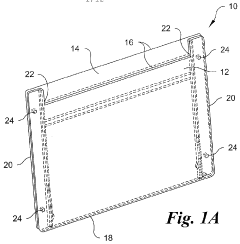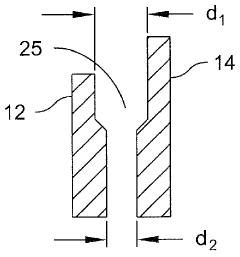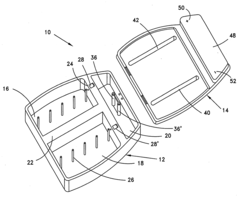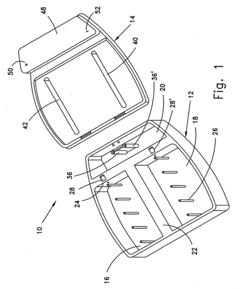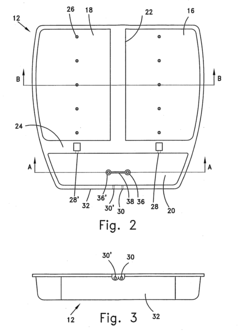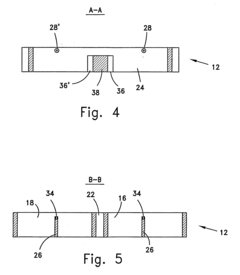Gel Electrophoresis: A Guide to Efficient Sample Preparation
JUN 30, 20259 MIN READ
Generate Your Research Report Instantly with AI Agent
Patsnap Eureka helps you evaluate technical feasibility & market potential.
Gel Electrophoresis Background and Objectives
Gel electrophoresis has been a cornerstone technique in molecular biology and biochemistry since its inception in the 1960s. This method, which separates molecules based on their size and electrical charge, has revolutionized the analysis of DNA, RNA, and proteins. The technique's development can be traced back to the work of Arne Tiselius, who first demonstrated the separation of proteins using electrophoresis in the 1930s. However, it was the introduction of gel matrices in the 1950s that significantly enhanced the resolution and applicability of the method.
The evolution of gel electrophoresis has been marked by continuous improvements in gel composition, buffer systems, and detection methods. From the early use of starch gels to the widespread adoption of agarose and polyacrylamide gels, each advancement has expanded the technique's capabilities and precision. The introduction of pulsed-field gel electrophoresis in the 1980s further extended the size range of DNA fragments that could be effectively separated, enabling the analysis of entire chromosomes.
In recent years, the focus has shifted towards enhancing the efficiency and reproducibility of gel electrophoresis, particularly in sample preparation. This aspect is crucial as it directly impacts the quality of results and the reliability of downstream applications. The current technological trend is aimed at developing standardized protocols and automated systems for sample preparation to minimize variability and improve throughput.
The objectives of modern gel electrophoresis research and development are multifaceted. Firstly, there is a drive to increase sensitivity, allowing for the detection and analysis of ever-smaller quantities of biological molecules. This is particularly important in fields such as forensics and diagnostics, where sample material may be limited. Secondly, there is a push towards miniaturization and integration with other analytical techniques, leading to the development of lab-on-a-chip devices that incorporate gel electrophoresis.
Another key objective is to enhance the speed of analysis without compromising resolution. This is being addressed through the development of high-voltage systems and novel gel formulations. Additionally, there is a growing emphasis on making gel electrophoresis more environmentally friendly by reducing the use of toxic chemicals and minimizing waste.
As we look to the future, the goals for gel electrophoresis technology include real-time analysis capabilities, increased automation, and seamless integration with bioinformatics tools. These advancements aim to transform gel electrophoresis from a standalone analytical technique into a comprehensive, high-throughput platform for molecular analysis, capable of meeting the evolving needs of genomics, proteomics, and personalized medicine.
The evolution of gel electrophoresis has been marked by continuous improvements in gel composition, buffer systems, and detection methods. From the early use of starch gels to the widespread adoption of agarose and polyacrylamide gels, each advancement has expanded the technique's capabilities and precision. The introduction of pulsed-field gel electrophoresis in the 1980s further extended the size range of DNA fragments that could be effectively separated, enabling the analysis of entire chromosomes.
In recent years, the focus has shifted towards enhancing the efficiency and reproducibility of gel electrophoresis, particularly in sample preparation. This aspect is crucial as it directly impacts the quality of results and the reliability of downstream applications. The current technological trend is aimed at developing standardized protocols and automated systems for sample preparation to minimize variability and improve throughput.
The objectives of modern gel electrophoresis research and development are multifaceted. Firstly, there is a drive to increase sensitivity, allowing for the detection and analysis of ever-smaller quantities of biological molecules. This is particularly important in fields such as forensics and diagnostics, where sample material may be limited. Secondly, there is a push towards miniaturization and integration with other analytical techniques, leading to the development of lab-on-a-chip devices that incorporate gel electrophoresis.
Another key objective is to enhance the speed of analysis without compromising resolution. This is being addressed through the development of high-voltage systems and novel gel formulations. Additionally, there is a growing emphasis on making gel electrophoresis more environmentally friendly by reducing the use of toxic chemicals and minimizing waste.
As we look to the future, the goals for gel electrophoresis technology include real-time analysis capabilities, increased automation, and seamless integration with bioinformatics tools. These advancements aim to transform gel electrophoresis from a standalone analytical technique into a comprehensive, high-throughput platform for molecular analysis, capable of meeting the evolving needs of genomics, proteomics, and personalized medicine.
Market Demand Analysis for Gel Electrophoresis
The market demand for gel electrophoresis continues to grow steadily, driven by increasing applications in molecular biology, genetics, and biochemistry research. This technique remains a cornerstone in various scientific fields, including genomics, proteomics, and forensic science. The global gel electrophoresis market is experiencing robust growth, with a significant portion attributed to the demand for efficient sample preparation methods.
Research institutions, pharmaceutical companies, and biotechnology firms are the primary consumers of gel electrophoresis products and services. The rising prevalence of genetic disorders and infectious diseases has led to increased funding for genomics research, further fueling the demand for gel electrophoresis techniques. Additionally, the growing focus on personalized medicine and biomarker discovery has expanded the application scope of gel electrophoresis in clinical diagnostics and drug development.
The market for gel electrophoresis sample preparation products is particularly dynamic. Researchers and laboratories are constantly seeking more efficient, reproducible, and cost-effective methods for sample preparation. This demand is driving innovations in buffer formulations, loading dyes, and sample purification kits designed specifically for gel electrophoresis applications.
Emerging trends in the gel electrophoresis market include the integration of automation and high-throughput capabilities. Laboratories are increasingly adopting automated sample preparation systems to improve efficiency and reduce human error. This shift towards automation is expected to continue, creating new opportunities for manufacturers of gel electrophoresis equipment and consumables.
The COVID-19 pandemic has had a significant impact on the gel electrophoresis market. The urgent need for rapid diagnostic tools and vaccine development has led to increased utilization of gel electrophoresis techniques in virus research and testing. This surge in demand is likely to have long-lasting effects on the market, as it has highlighted the importance of molecular biology techniques in public health responses.
Geographically, North America and Europe remain the largest markets for gel electrophoresis products, owing to their well-established research infrastructure and high R&D investments. However, the Asia-Pacific region is emerging as a rapidly growing market, driven by increasing government funding for life sciences research and the expansion of biotechnology and pharmaceutical industries in countries like China and India.
In conclusion, the market demand for gel electrophoresis, particularly in the area of efficient sample preparation, is robust and expected to continue growing. The combination of established applications and emerging research areas, coupled with technological advancements, ensures a positive outlook for the gel electrophoresis market in the coming years.
Research institutions, pharmaceutical companies, and biotechnology firms are the primary consumers of gel electrophoresis products and services. The rising prevalence of genetic disorders and infectious diseases has led to increased funding for genomics research, further fueling the demand for gel electrophoresis techniques. Additionally, the growing focus on personalized medicine and biomarker discovery has expanded the application scope of gel electrophoresis in clinical diagnostics and drug development.
The market for gel electrophoresis sample preparation products is particularly dynamic. Researchers and laboratories are constantly seeking more efficient, reproducible, and cost-effective methods for sample preparation. This demand is driving innovations in buffer formulations, loading dyes, and sample purification kits designed specifically for gel electrophoresis applications.
Emerging trends in the gel electrophoresis market include the integration of automation and high-throughput capabilities. Laboratories are increasingly adopting automated sample preparation systems to improve efficiency and reduce human error. This shift towards automation is expected to continue, creating new opportunities for manufacturers of gel electrophoresis equipment and consumables.
The COVID-19 pandemic has had a significant impact on the gel electrophoresis market. The urgent need for rapid diagnostic tools and vaccine development has led to increased utilization of gel electrophoresis techniques in virus research and testing. This surge in demand is likely to have long-lasting effects on the market, as it has highlighted the importance of molecular biology techniques in public health responses.
Geographically, North America and Europe remain the largest markets for gel electrophoresis products, owing to their well-established research infrastructure and high R&D investments. However, the Asia-Pacific region is emerging as a rapidly growing market, driven by increasing government funding for life sciences research and the expansion of biotechnology and pharmaceutical industries in countries like China and India.
In conclusion, the market demand for gel electrophoresis, particularly in the area of efficient sample preparation, is robust and expected to continue growing. The combination of established applications and emerging research areas, coupled with technological advancements, ensures a positive outlook for the gel electrophoresis market in the coming years.
Current Challenges in Sample Preparation
Despite significant advancements in gel electrophoresis techniques, sample preparation remains a critical challenge in achieving accurate and reproducible results. One of the primary issues is the inconsistency in sample quality, which can lead to variations in band intensity and resolution. This problem is often exacerbated by the complexity of biological samples, which may contain interfering substances that affect the migration of molecules through the gel matrix.
Another significant challenge is the time-consuming nature of sample preparation. Traditional methods often involve multiple steps, including cell lysis, protein extraction, and buffer exchange, which can be labor-intensive and prone to errors. This not only reduces throughput but also increases the risk of sample degradation or loss during the preparation process.
The limited sample volume available for analysis poses an additional hurdle, particularly when working with rare or precious samples. Researchers often struggle to balance the need for sufficient material to generate detectable signals with the desire to conserve samples for other analyses or replicate experiments.
Sample stability during preparation and storage is another critical concern. Proteins, in particular, are susceptible to degradation, aggregation, or modification, which can alter their electrophoretic behavior and lead to misleading results. Maintaining sample integrity throughout the preparation process is essential for obtaining reliable data.
The presence of contaminants in samples remains a persistent challenge. Salts, lipids, and other cellular components can interfere with the electrophoretic separation, causing smearing, distorted bands, or altered migration patterns. Removing these contaminants without compromising the target molecules requires careful optimization of purification protocols.
Standardization of sample preparation methods across different laboratories and experiments is yet another hurdle. The lack of universally accepted protocols can lead to discrepancies in results and hinder the comparison of data between studies. This variability undermines the reproducibility and reliability of gel electrophoresis experiments.
Lastly, the adaptation of sample preparation techniques to emerging gel electrophoresis applications, such as two-dimensional electrophoresis or capillary electrophoresis, presents ongoing challenges. These advanced techniques often require more stringent sample quality and purity, necessitating the development of specialized preparation methods tailored to specific applications.
Another significant challenge is the time-consuming nature of sample preparation. Traditional methods often involve multiple steps, including cell lysis, protein extraction, and buffer exchange, which can be labor-intensive and prone to errors. This not only reduces throughput but also increases the risk of sample degradation or loss during the preparation process.
The limited sample volume available for analysis poses an additional hurdle, particularly when working with rare or precious samples. Researchers often struggle to balance the need for sufficient material to generate detectable signals with the desire to conserve samples for other analyses or replicate experiments.
Sample stability during preparation and storage is another critical concern. Proteins, in particular, are susceptible to degradation, aggregation, or modification, which can alter their electrophoretic behavior and lead to misleading results. Maintaining sample integrity throughout the preparation process is essential for obtaining reliable data.
The presence of contaminants in samples remains a persistent challenge. Salts, lipids, and other cellular components can interfere with the electrophoretic separation, causing smearing, distorted bands, or altered migration patterns. Removing these contaminants without compromising the target molecules requires careful optimization of purification protocols.
Standardization of sample preparation methods across different laboratories and experiments is yet another hurdle. The lack of universally accepted protocols can lead to discrepancies in results and hinder the comparison of data between studies. This variability undermines the reproducibility and reliability of gel electrophoresis experiments.
Lastly, the adaptation of sample preparation techniques to emerging gel electrophoresis applications, such as two-dimensional electrophoresis or capillary electrophoresis, presents ongoing challenges. These advanced techniques often require more stringent sample quality and purity, necessitating the development of specialized preparation methods tailored to specific applications.
Existing Sample Preparation Methods
01 Sample loading and buffer preparation
Proper sample loading and buffer preparation are crucial for gel electrophoresis. This involves mixing the sample with a loading buffer containing dyes and density agents to facilitate sample tracking and ensure it sinks into the well. The buffer composition is optimized to maintain sample stability and enhance separation.- Sample loading techniques: Various techniques are used for loading samples into gel electrophoresis systems. These include automated sample loading devices, microfluidic channels, and specialized sample wells. These methods aim to improve precision, reduce contamination, and increase throughput in gel electrophoresis experiments.
- Buffer and reagent preparation: Proper preparation of buffers and reagents is crucial for successful gel electrophoresis. This includes formulating running buffers, loading dyes, and staining solutions. The composition and concentration of these components can significantly affect the separation and visualization of samples.
- Sample purification and concentration: Prior to loading, samples often require purification and concentration steps. This may involve techniques such as centrifugation, filtration, or precipitation to remove contaminants and increase the concentration of target molecules. These steps help improve the resolution and sensitivity of gel electrophoresis.
- Denaturing and reducing agents: The use of denaturing and reducing agents is common in sample preparation for gel electrophoresis, particularly for protein analysis. These agents help unfold proteins and break disulfide bonds, ensuring consistent migration patterns. Common agents include SDS, urea, and beta-mercaptoethanol.
- Specialized sample preparation for different biomolecules: Different types of biomolecules (DNA, RNA, proteins) require specific sample preparation techniques. This includes DNA fragmentation methods, RNA stabilization, and protein solubilization protocols. These specialized techniques ensure optimal separation and analysis of the target molecules during gel electrophoresis.
02 DNA and protein sample preparation
Specific techniques are employed for preparing DNA and protein samples for gel electrophoresis. This may include DNA extraction, purification, and fragmentation methods, as well as protein denaturation and reduction processes. The preparation steps are tailored to the type of biomolecule and the desired analysis outcome.Expand Specific Solutions03 Automated sample preparation systems
Automated systems have been developed to streamline the gel electrophoresis sample preparation process. These systems can handle multiple samples simultaneously, reducing manual labor and improving reproducibility. They often integrate various preparation steps, such as mixing, heating, and loading, into a single automated workflow.Expand Specific Solutions04 Sample concentration and purification
Techniques for concentrating and purifying samples prior to gel electrophoresis are essential for improving resolution and sensitivity. This may involve methods such as precipitation, filtration, or column-based purification to remove contaminants and increase the concentration of target molecules in the sample.Expand Specific Solutions05 Specialized sample preparation for specific applications
Certain gel electrophoresis applications require specialized sample preparation techniques. This includes methods for preparing samples for 2D gel electrophoresis, capillary electrophoresis, or pulsed-field gel electrophoresis. These techniques often involve unique steps to address the specific requirements of each application.Expand Specific Solutions
Key Players in Gel Electrophoresis Industry
The gel electrophoresis market is in a mature stage, with established players and well-defined applications across life sciences research and diagnostics. The global market size for gel electrophoresis is estimated to be in the billions of dollars, driven by increasing demand in genomics, proteomics, and clinical diagnostics. Technologically, gel electrophoresis has evolved significantly, with companies like Life Technologies, Bio-Rad Laboratories, and Beckman Coulter leading innovations in automated systems and high-throughput solutions. These industry leaders, along with emerging players such as Sage Science, are continually improving sample preparation techniques, enhancing resolution, and integrating digital analysis capabilities to meet the growing needs of researchers and clinicians in various fields of molecular biology and biomedical research.
Bio-Rad Laboratories, Inc.
Technical Solution: Bio-Rad has developed innovative solutions for gel electrophoresis sample preparation, including their Precision Plus Protein™ Standards. These pre-stained protein standards offer exceptional lot-to-lot consistency and are designed for precise molecular weight determination[1]. Their sample preparation kits, such as the ReadyPrep™ 2-D Cleanup Kit, effectively remove interfering compounds like salts, lipids, and nucleic acids, ensuring high-quality protein samples for gel electrophoresis[2]. Bio-Rad's Experion™ Automated Electrophoresis System integrates sample preparation, separation, staining, destaining, imaging, quantitation, and data analysis into a single platform, significantly reducing hands-on time and improving reproducibility[3].
Strengths: Comprehensive product range, high precision standards, automated systems for improved efficiency. Weaknesses: Higher cost compared to basic methods, may require specialized training for advanced systems.
Beckman Coulter, Inc.
Technical Solution: Beckman Coulter has developed the ProteomeLab™ PA 800 plus Pharmaceutical Analysis System, which integrates capillary electrophoresis with various detection methods for efficient sample preparation and analysis. This system offers high-resolution separations and can handle small sample volumes, making it ideal for protein characterization and purity analysis[4]. Their Biomek® Automated Workstations provide customizable liquid handling solutions for sample preparation, including protein and nucleic acid extraction, purification, and normalization[5]. Beckman Coulter's DelsaMax Pro Dynamic Light Scattering system aids in sample quality assessment before gel electrophoresis, ensuring optimal results by detecting aggregates or contaminants[6].
Strengths: Advanced automation capabilities, high-resolution analysis, versatile applications. Weaknesses: Complex systems may require specialized training, higher initial investment compared to manual methods.
Innovations in Sample Preparation Techniques
Gel electrophoresis device for loading large sample volumes
PatentWO2014081625A1
Innovation
- A gel cassette with a stepped configuration and a comb design that increases the volume of sample wells without altering the gel thickness, featuring a plate-to-plate distance variation and a groove to stabilize the well walls, allowing for larger sample loading with improved resolution.
Double Chamber Tank for Horizontal Gel Electrophoresis
PatentInactiveUS20080217178A1
Innovation
- A tank apparatus with two independent buffer chambers separated by a partition, allowing communication with a gel matrix but not each other, featuring a cover with vents and a heat sink for uniform heat distribution, and a microswitch for safe electrical activation, using a small buffer volume and platinum electrodes for efficient separation.
Safety and Regulatory Considerations
Gel electrophoresis is a widely used technique in molecular biology and biochemistry laboratories, requiring careful attention to safety and regulatory considerations. The handling of potentially hazardous materials and the use of electrical equipment necessitate strict adherence to safety protocols and regulatory guidelines.
Laboratory personnel must be trained in proper safety procedures, including the use of personal protective equipment (PPE) such as gloves, lab coats, and safety goggles. These measures protect against exposure to harmful chemicals and biological materials used in sample preparation and electrophoresis. Additionally, proper handling and disposal of hazardous waste, including used gels and buffers, is essential to comply with environmental regulations and prevent contamination.
Electrical safety is paramount when working with gel electrophoresis equipment. Power supplies and electrophoresis chambers must be regularly inspected and maintained to prevent electrical hazards. Proper grounding and insulation of equipment are crucial to minimize the risk of electric shock. Laboratories should establish clear protocols for the safe operation of electrophoresis equipment, including guidelines for connecting and disconnecting power supplies.
Chemical safety is another critical aspect of gel electrophoresis. Many reagents used in sample preparation and electrophoresis, such as acrylamide and ethidium bromide, are known toxins or potential carcinogens. Proper storage, handling, and disposal of these chemicals are essential to protect laboratory personnel and the environment. Material Safety Data Sheets (MSDS) for all chemicals should be readily accessible, and staff should be trained in their interpretation and use.
Regulatory compliance is a key consideration in gel electrophoresis procedures. Laboratories must adhere to local, national, and international regulations governing the use of biological materials, genetically modified organisms, and hazardous chemicals. This may include obtaining necessary permits, maintaining detailed records of experiments and sample handling, and participating in regular safety audits.
Quality control measures are essential to ensure the reliability and reproducibility of gel electrophoresis results. This includes regular calibration of equipment, validation of protocols, and implementation of standard operating procedures (SOPs). Proper documentation of these processes is crucial for regulatory compliance and may be subject to inspection by regulatory bodies.
Biosafety considerations are particularly important when working with potentially infectious samples or genetically modified organisms. Appropriate containment measures, such as the use of biosafety cabinets and proper decontamination procedures, must be implemented to prevent the release of hazardous biological materials.
In conclusion, adherence to safety protocols and regulatory guidelines is essential for the responsible and effective use of gel electrophoresis in research and diagnostic settings. Regular training, robust safety management systems, and a culture of safety awareness are crucial elements in maintaining a safe and compliant laboratory environment.
Laboratory personnel must be trained in proper safety procedures, including the use of personal protective equipment (PPE) such as gloves, lab coats, and safety goggles. These measures protect against exposure to harmful chemicals and biological materials used in sample preparation and electrophoresis. Additionally, proper handling and disposal of hazardous waste, including used gels and buffers, is essential to comply with environmental regulations and prevent contamination.
Electrical safety is paramount when working with gel electrophoresis equipment. Power supplies and electrophoresis chambers must be regularly inspected and maintained to prevent electrical hazards. Proper grounding and insulation of equipment are crucial to minimize the risk of electric shock. Laboratories should establish clear protocols for the safe operation of electrophoresis equipment, including guidelines for connecting and disconnecting power supplies.
Chemical safety is another critical aspect of gel electrophoresis. Many reagents used in sample preparation and electrophoresis, such as acrylamide and ethidium bromide, are known toxins or potential carcinogens. Proper storage, handling, and disposal of these chemicals are essential to protect laboratory personnel and the environment. Material Safety Data Sheets (MSDS) for all chemicals should be readily accessible, and staff should be trained in their interpretation and use.
Regulatory compliance is a key consideration in gel electrophoresis procedures. Laboratories must adhere to local, national, and international regulations governing the use of biological materials, genetically modified organisms, and hazardous chemicals. This may include obtaining necessary permits, maintaining detailed records of experiments and sample handling, and participating in regular safety audits.
Quality control measures are essential to ensure the reliability and reproducibility of gel electrophoresis results. This includes regular calibration of equipment, validation of protocols, and implementation of standard operating procedures (SOPs). Proper documentation of these processes is crucial for regulatory compliance and may be subject to inspection by regulatory bodies.
Biosafety considerations are particularly important when working with potentially infectious samples or genetically modified organisms. Appropriate containment measures, such as the use of biosafety cabinets and proper decontamination procedures, must be implemented to prevent the release of hazardous biological materials.
In conclusion, adherence to safety protocols and regulatory guidelines is essential for the responsible and effective use of gel electrophoresis in research and diagnostic settings. Regular training, robust safety management systems, and a culture of safety awareness are crucial elements in maintaining a safe and compliant laboratory environment.
Cost-Effectiveness Analysis
Cost-effectiveness analysis is a crucial aspect of implementing gel electrophoresis techniques in laboratory settings. This analysis aims to evaluate the economic efficiency of sample preparation methods for gel electrophoresis, considering both the costs involved and the quality of results obtained.
One of the primary factors influencing cost-effectiveness is the choice of reagents and materials used in sample preparation. High-quality commercial kits often provide consistent results but come at a premium price. In contrast, in-house prepared buffers and solutions can significantly reduce costs but may require more time and expertise to optimize. A balanced approach, combining selective use of commercial products with in-house preparations, can offer a cost-effective solution without compromising quality.
Equipment selection also plays a vital role in the overall cost-effectiveness of gel electrophoresis sample preparation. While advanced automated systems can increase throughput and reduce hands-on time, their high initial investment may not be justified for laboratories with lower sample volumes. Traditional manual methods, though more labor-intensive, can be more cost-effective for smaller-scale operations or when budget constraints are significant.
Sample preparation protocols can be optimized to improve cost-effectiveness. Minimizing the use of expensive enzymes or reagents, reducing the number of steps in the preparation process, and maximizing the efficiency of each step can lead to significant cost savings over time. Additionally, implementing strategies to reduce sample loss during preparation can increase the yield of usable material, thereby improving the overall cost-effectiveness of the process.
The scale of operations is another critical factor in cost-effectiveness analysis. Bulk purchasing of reagents and consumables can lead to substantial savings for high-throughput laboratories. However, smaller labs must carefully balance bulk discounts against the risk of reagent expiration and storage costs. Implementing just-in-time inventory management can help optimize resource utilization and minimize waste.
Training and personnel costs are often overlooked in cost-effectiveness analyses but can significantly impact the overall efficiency of gel electrophoresis sample preparation. Investing in comprehensive training programs can lead to improved sample quality, reduced errors, and increased productivity, ultimately resulting in long-term cost savings. Additionally, cross-training personnel to perform multiple tasks can enhance operational flexibility and reduce labor costs.
Lastly, the long-term sustainability and scalability of sample preparation methods should be considered in cost-effectiveness analyses. Methods that can easily adapt to changing sample types or volumes without requiring significant additional investment are generally more cost-effective in the long run. This flexibility allows laboratories to respond to evolving research needs without incurring substantial new costs.
One of the primary factors influencing cost-effectiveness is the choice of reagents and materials used in sample preparation. High-quality commercial kits often provide consistent results but come at a premium price. In contrast, in-house prepared buffers and solutions can significantly reduce costs but may require more time and expertise to optimize. A balanced approach, combining selective use of commercial products with in-house preparations, can offer a cost-effective solution without compromising quality.
Equipment selection also plays a vital role in the overall cost-effectiveness of gel electrophoresis sample preparation. While advanced automated systems can increase throughput and reduce hands-on time, their high initial investment may not be justified for laboratories with lower sample volumes. Traditional manual methods, though more labor-intensive, can be more cost-effective for smaller-scale operations or when budget constraints are significant.
Sample preparation protocols can be optimized to improve cost-effectiveness. Minimizing the use of expensive enzymes or reagents, reducing the number of steps in the preparation process, and maximizing the efficiency of each step can lead to significant cost savings over time. Additionally, implementing strategies to reduce sample loss during preparation can increase the yield of usable material, thereby improving the overall cost-effectiveness of the process.
The scale of operations is another critical factor in cost-effectiveness analysis. Bulk purchasing of reagents and consumables can lead to substantial savings for high-throughput laboratories. However, smaller labs must carefully balance bulk discounts against the risk of reagent expiration and storage costs. Implementing just-in-time inventory management can help optimize resource utilization and minimize waste.
Training and personnel costs are often overlooked in cost-effectiveness analyses but can significantly impact the overall efficiency of gel electrophoresis sample preparation. Investing in comprehensive training programs can lead to improved sample quality, reduced errors, and increased productivity, ultimately resulting in long-term cost savings. Additionally, cross-training personnel to perform multiple tasks can enhance operational flexibility and reduce labor costs.
Lastly, the long-term sustainability and scalability of sample preparation methods should be considered in cost-effectiveness analyses. Methods that can easily adapt to changing sample types or volumes without requiring significant additional investment are generally more cost-effective in the long run. This flexibility allows laboratories to respond to evolving research needs without incurring substantial new costs.
Unlock deeper insights with Patsnap Eureka Quick Research — get a full tech report to explore trends and direct your research. Try now!
Generate Your Research Report Instantly with AI Agent
Supercharge your innovation with Patsnap Eureka AI Agent Platform!
